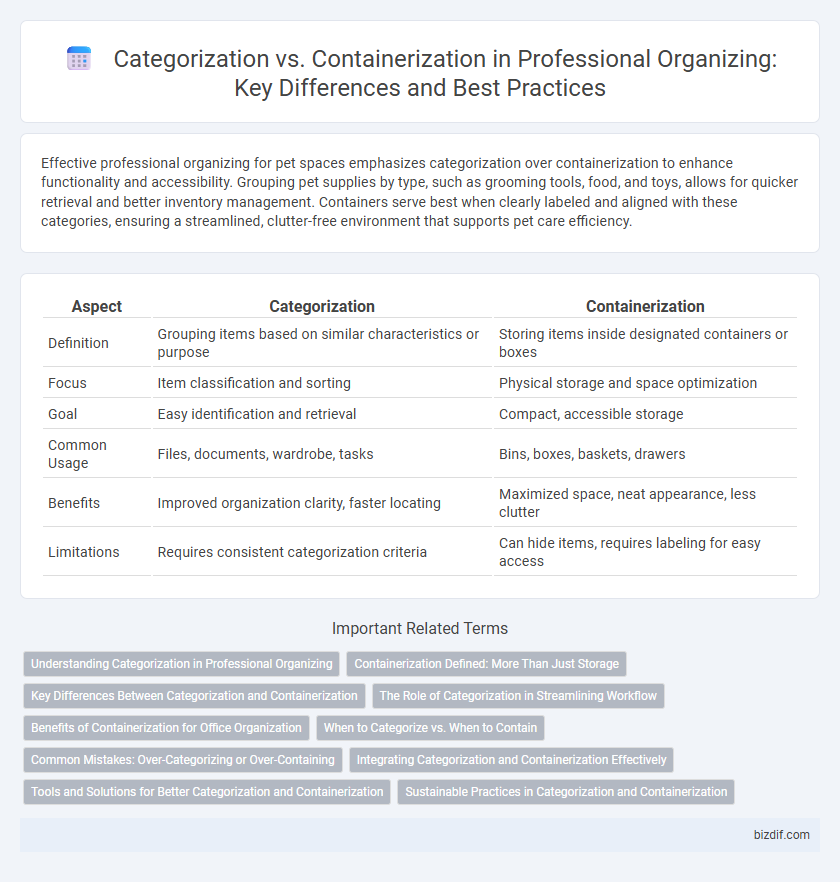Effective professional organizing for pet spaces emphasizes categorization over containerization to enhance functionality and accessibility. Grouping pet supplies by type, such as grooming tools, food, and toys, allows for quicker retrieval and better inventory management. Containers serve best when clearly labeled and aligned with these categories, ensuring a streamlined, clutter-free environment that supports pet care efficiency.
Table of Comparison
| Aspect | Categorization | Containerization |
|---|---|---|
| Definition | Grouping items based on similar characteristics or purpose | Storing items inside designated containers or boxes |
| Focus | Item classification and sorting | Physical storage and space optimization |
| Goal | Easy identification and retrieval | Compact, accessible storage |
| Common Usage | Files, documents, wardrobe, tasks | Bins, boxes, baskets, drawers |
| Benefits | Improved organization clarity, faster locating | Maximized space, neat appearance, less clutter |
| Limitations | Requires consistent categorization criteria | Can hide items, requires labeling for easy access |
Understanding Categorization in Professional Organizing
Understanding categorization in professional organizing enhances efficiency by grouping items based on function, frequency of use, or environment, which simplifies retrieval and maintenance. This method prioritizes logical organization over mere containment, ensuring that each category reflects a user's lifestyle and habits accurately. Proper categorization reduces clutter by avoiding unnecessary containers and promotes a streamlined space tailored to individual needs.
Containerization Defined: More Than Just Storage
Containerization in professional organizing goes beyond mere storage by enhancing accessibility and efficiency through strategic grouping of items within purpose-specific containers. This method promotes streamlined retrieval and visual order, optimizing space utilization and reducing clutter. Effective containerization integrates categorization principles but emphasizes physical boundaries that support maintenance and functional flow in organized environments.
Key Differences Between Categorization and Containerization
Categorization involves sorting items based on shared characteristics or functions, enabling easier identification and access, while containerization focuses on grouping items into physical or digital containers for storage and space optimization. Categorization enhances retrieval efficiency through logical grouping, whereas containerization emphasizes physical organization and containment. Understanding these distinctions allows professional organizers to create systems that balance accessibility with spatial management.
The Role of Categorization in Streamlining Workflow
Categorization plays a crucial role in streamlining workflow by enabling professionals to group similar items based on function, purpose, or frequency of use, which reduces search time and minimizes clutter. Unlike containerization, which focuses on physical storage solutions, categorization prioritizes mental mapping and accessibility, enhancing efficiency in task execution. Implementing clear, consistent categories allows for faster decision-making and improved productivity in both personal and professional organizing systems.
Benefits of Containerization for Office Organization
Containerization in office organization streamlines space utilization by consolidating similar items into designated containers, significantly reducing clutter and enhancing accessibility. Clear, labeled containers foster quick identification and retrieval, boosting productivity and minimizing time spent searching for supplies or documents. This method also protects office materials from damage and helps maintain a neat, professional workspace conducive to effective workflow.
When to Categorize vs. When to Contain
Categorization is essential when items need to be sorted based on function, frequency of use, or type to enhance accessibility and decision-making. Containerization works best when physical segregation can reduce clutter or protect items but doesn't require detailed sorting, such as seasonal storage or bulk supplies. Combining categorization with strategic containerization maximizes organization efficiency, ensuring both clarity and tidy physical boundaries.
Common Mistakes: Over-Categorizing or Over-Containing
Over-categorizing creates unnecessary complexity, making it difficult to locate items quickly and reducing overall efficiency in professional organizing. Over-containing leads to wasted space and cluttered storage solutions, hindering easy access and usability. Optimal organizing balances categorization and containerization to streamline spaces while maintaining functional order.
Integrating Categorization and Containerization Effectively
Integrating categorization and containerization effectively enhances overall organization by assigning clear functions to both processes: categorization sorts items based on purpose or usage, while containerization groups these sorted items within physical or digital containers. Prioritizing logical categorization before selecting appropriate containers ensures ease of access and maximizes storage efficiency, reducing clutter and search time. Utilizing labeled containers aligned with specific categories streamlines maintenance and reinforces consistent organizational habits across professional spaces.
Tools and Solutions for Better Categorization and Containerization
Effective professional organizing relies on strategic categorization techniques supported by tools like labeling systems, color-coded bins, and digital inventory apps to streamline item identification and retrieval. Containerization solutions, including stackable storage containers, modular shelving units, and drawer organizers, maximize space efficiency while maintaining accessibility. Combining these tools enhances organization by clearly defining categories and creating customized, functional storage that adapts to individual needs.
Sustainable Practices in Categorization and Containerization
Sustainable practices in professional organizing emphasize the use of eco-friendly materials for containers, such as recycled plastics or bamboo, to minimize environmental impact. Prioritizing categorization techniques that reduce clutter and promote mindful consumption supports long-term organization and decreases waste generation. Implementing reusable, durable containers combined with strategic categorization enhances space efficiency while aligning with sustainable living principles.
categorization vs containerization Infographic

 bizdif.com
bizdif.com